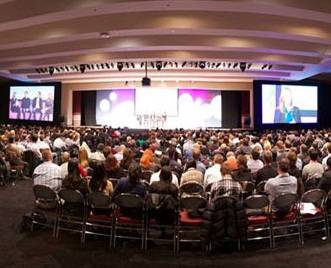ad:tech New Delhi 2013: Day 2 at a glance...
The third India edition of the world’s #1 digital marketing event, ad:tech New Delhi 2013, witnessed unprecedented response from the speakers, global advertisers and marketers, leading brands, publishers, and exhibitors. The two day conference attracted a footfall of more than 3000 attendees who deliberated on topics such as integrated mobile marketing, video integration, location-based relevancy, social media ROI, search and content.
The second day of ad:tech New Delhi highlighted gamification as the latest trend for this year and predicted that it will become a major global experience by 2016. Globally, there are more than 500 million people playing games at least for an hour a day.
Alyssa Altman, Vice President, SapientNitro stressed on the need for balancing local with global marketing to overcome challenges of bespoke adoption which is opportunistic but also can be inefficient from a budgeting perspective due to increasing channel saturation and explosion in competition. While sharing the findings she said that 88 percent of respondents believe that today’s global marketing world has become challenging than ever before. She also cited a Gartner study which predicts that by 2017, CMOs will purchase more technology than CIOs.
The second keynote addressed by Durga Raghunath, VP Product and Executive News, Firstpost explored changing news creation and consumption patterns from Network18 newsrooms to mark new trends for the future.
In the panel session: ‘Smart Or Dumb? Integrated Mobile Marketing That Engages Your Mobile Customers’, the panelists stressed upon the changing landscape of today. They believe that in today’s modern landscape, having a mobile strategy is no longer optional for your business. However the rapidly evolving space of mobile technology has only increased the difficulty marketer’s face in deciding a clear mobile strategy. The growth of smart phones has increased exponentially, but more than 87% of mobile subscribers in the India still use a traditional feature phone. From sms and voice marketing to newer, more technologically advanced tactics such as QR codes, apps and augmented reality, marketers need to get their marketing strategy correct to leverage on the true potential of this media that reaches more than 918 million Indians.
Anisha Singh, Founder & CEO, mydala.com says, “In terms of future timeline the growth of smartphone will be robust. The line between the smartphone and the feature phone is quite thin. They have made the users engage quite literally.”
Rohan Verma, Director, MapmyIndia says, “Location plays an important role when it comes to advertising and building business strategies. It is really important how you place your store.”
Building on the theme of location-based relevance, Mohammed Imthiaz of Hoppr said that there are only 20 million smart phone users in India which is why marketers need to plan campaigns that can run on every type of phone.
Giving the analogy of feet, folks and fingers, he said that location-based services can help make the typical lean hours into peak hours. He mentioned that for a consumer, more than any discount or badges or other rewards, the real benefit a marketer can provide is the joy of watching and sharing content.
Avinash Jhangiani, Vice President – Digital, Omnicom Media Group, explained about their game changing live collaboration platform for global media planning, ‘SOURCE’, which can even create powerpoint decks automatically. He also shared examples of brands like Visa, Mahindra and Movie Munchies that have successfully gamified their campaigns.
Citing the example of Mario Bros., Rahul Avasthy, Director Strategy for Zapak Digital Entertainment, said that the same game mechanics can be applied to non-game real-life experiences to help solve the challenges of bounce rate and converting latent leads (CPL). He noted that successful campaigns require not just good content but also intent, citing the example of Arby’s Burger which leveraged gamification generated over 41,000 organic entrants and 3,00,000 actions.
This year’s ad:tech also saw exhibitors running several contests to engage with thousands of marketers attending the event. In one such sms-based contest, three lucky winners took away iPad Minis by correctly answering technology-related questions.
Another panel discussion covered how video consumption over the Internet through "non-TV" environment (i.e. PC and mobile devices) is slowly catching up India. Consumer behavior and consumption is changing with the rise of Smartphone and Tablets usage.
Praveen Sharma, Head of Media Sales, Google India, stressed that with explosion of multi-screens poses challenge for content creators as the viewers filter out the mediocrity on screens other than the TV. He says, “Video consumption and adoption across the ecosystem is enabling the users, content creators and adopters to engage more. The task for advertisers today is to advertise on all the screens that a consumer is using.”
T Gangadhar, MD, MEC India said, “As a media agency, we are moving away from media planning to audience planning. We consider YouTube as a channel. Plans are increasingly becoming video plans.”
Prashant Singh, MD – Media, Nielsen India said, “It is important for a digital campaign to be based on three parameters: reach, resonance and reaction. Getting these three basics right would help measure the ROI.” Pratik Mazumder, Head Marketing and Strategic Relations, Yatra.com highlighted the fact that while brands are insistent on ROI from digital media, many brands do not move beyond ‘Likes’ on social media to engage with the consumer.
While Sunita Natrajan in her presentation on the topic; Revenue At the Speed of User Adoption stressed on the points like what are the appropriate measurement points across platforms that align with a consumer who is increasingly platform agnostic but have specific needs of their devices. She also spoke about how to manage the complexities of advertising economics as they become more complicated and explained how to adjust to the challenge of driving revenue at the speed of user adoption.
Bettina Sherick, SVP Digital Strategic Marketing, 20th Century Fox International spoke about Marketing the Digital Cinema Experience in a digital world. She stressed upon the fact that with the wide variety of digital entertainment choices, marketing the cinematic experience has become more challenging than ever. She says, “From gaming platforms to home entertainment, consumers have many opportunities readily available without even leaving the house. What is important is how do film marketers leverage the proliferation of digital devices for marketing purposes and at the same time how do they convince consumers to disconnect and experience films on the big screen.”
The two day conference stressed upon various topics enabling the attendees to learn a lot about the changing world scenario. From iPad Mini contests, free coffee vouchers and live dance games to donuts, chocolates, beer and bowling, only-ladies fun events, this year’s ad:tech in New Delhi surprised marketers with a large number of business networking opportunities. We can also conclude from this two day event that Gamification will be a global phenomenon by 2016 wherein CMOs will be seen to buy more technology than CIOs by year 2017.







Share
Facebook
YouTube
Tweet
Twitter
LinkedIn